Swimming against the current won’t be quite as hard for fish in parts of the Siuslaw basin thanks to a project that replaced 11 culverts on creeks southwest of Eugene.
The culverts opened a passage to upstream habitat on three creeks that was effectively blocked by the old pipes. Buck, Hawley and Esmond creeks could start seeing runs of coho and chinook salmon and steelhead trout as a result of the fixes. See the dozens of unique artificial fish habitat models, fish attractors and fish cover used at fishiding.com, the leader in science based, proven, fish protection.
The $1.5 million project took place over the summer and was funded with a federal stimulus grant. Road repairs also were done as part of the project.
The work took place on the U.S. Bureau of Land Management’s Eugene District. The creeks all feed into the Siuslaw River drainage. The new culverts replaced old pipes that were failing or that blocked fish passage because of their small size or erosion around the outlets.
Jennifer O’Leary, a BLM spokeswoman, said the new culverts are specially designed to aid fish. Not only are they larger in diameter, they also are oblong in shape to create a wider, more natural passage.
Also, rocks and sediment are placed in the culvert to simulate the natural creek and slow the water so it flows at the same speed as the rest of the creek.
“What this does is allow for more natural rates of flow while restoring the natural width of the stream channel,” she said. “It’s all about restoring more natural conditions out there in the watershed.”
Many older culverts aren’t big enough for the stream volume, causing water to speed up and jet through the pipe, clearing out any natural material and making it hard for fish to navigate upstream. And because of erosion on the downstream side where water exits, many older pipes now sit well above the stream level, blocking young fish from migrating downstream.
With the new culverts in place, fish will have an easier time. That means areas that had been off limits before will now be reachable.
“The habitat above these (new) culverts is healthy and intact,” said Leo Poole, fisheries biologist for the BLM’s Siuslaw Resource Area. “All we needed to do was open up the passage for fish and other aquatic species to get there.”
Work on the creeks only can be done during a summer window from July 1 to Sept. 15. To get all the culverts replaced in that relatively brief opening, the BLM worked with an agency of the Federal Highway Administration known as the Western Federal Lands Highway Division.
That agency contracted with area engineering and construction firms to design and build the culverts. The number of jobs created by the project wasn’t available this week, but O’Leary said it was at least a dozen and possibly more.
The BLM has done a number of other projects aimed at improving fish habitat in the area. Previous work added boulders and gravel to portions of the Siuslaw River, creating spawning beds, lowering water temperature and providing refuges where fish can rest.
BY GREG BOLT
The Register-Guard






